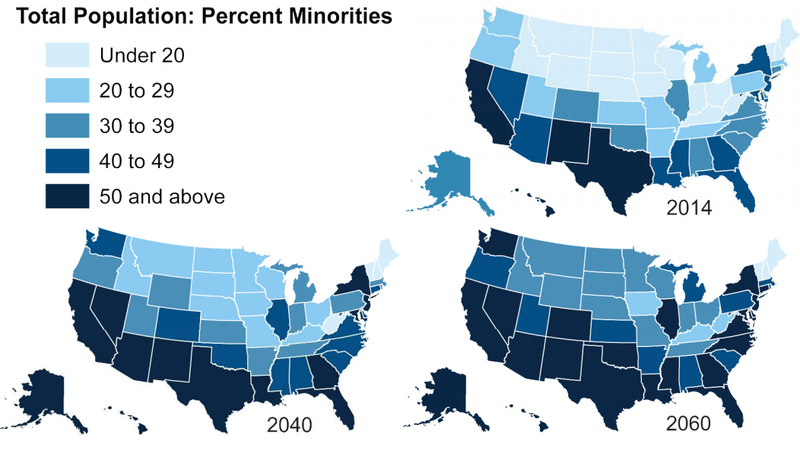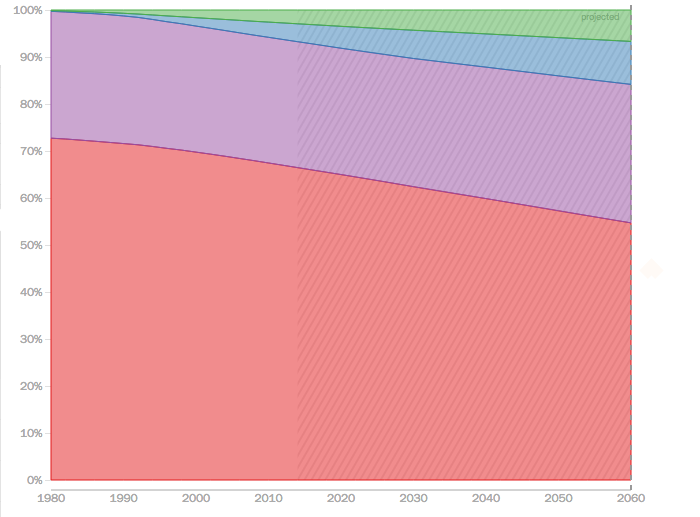
By 2044, racial minorities will become the majority of the population in the United States, according to a new study by the Center for American Progress, the American Enterprise Institute and the Brookings Institution. Eight years later, the majority of voters in the United States will be racial minorities.
Along the United States’ southern border, where racial minorities already make up a majority of the population in several states, the shift is happening even quicker. Of the 14 states projected to become majority minority by 2044, 8 of them are located along the U.S. southern border.
As the maps below illustrate, the growth of the minority population will boom across the South and continue to push further northward by 2060. And while racial minorities are not projected to become the majority population in Alabama any time in the foreseeable future, they will in the coming years make up a far greater percentage of the voting population than they do currently.
In 1980, whites made up 73 percent of Alabama’s population and blacks 27 percent. By 2000, the white population had only dropped to 70 percent, while the black population held steady and Hispanics and Asians picked up two percent each. That trend has essentially continued over the last decade-and-a-half. As of 2014, whites made up 66 percent of Alabama’s population, blacks 27 percent, Hispanics 4 percent and Asians/other 3 percent. But the trend is expected to accelerate between now and 2060. By 2060, whites will make up just 55 percent of Alabama’s population, blacks 29 percent, Hispanics 9 percent and Asians/other 7 percent.
So what does all of this mean politically?
The Washington Post’s political blog “The Fix” boldly stated that “this chart should terrify Republicans” on the national level.
“By 2060, 11 of the 15 largest states will be majority-minority — states that include electorally critical battlegrounds such as Florida, Arizona, Georgia, North Carolina and Virginia,” wrote The Fix’s Chris Cillizza. “When you consider that Mitt Romney won 27 percent of the Hispanic vote nationally (13 points worse than George W. Bush did eight years earlier), you begin to see that if things continue in their current direction, Republicans will be hard-pressed to be competitive in national elections in a decade or two.”
Texas, a state that is already majority minority, stands out as a model for what Republicans hope to accomplish across the country. The GOP controls all elected statewide offices in the Lone Star State, along with majorities in both chambers of the legislature.
“True,” wrote Cillizza, “but it’s worth noting that the Hispanic population, nationally and in Texas, is younger and less registered to vote as a percentage of its eligible voting population than any other demographic group. As that community ages and gets more acclimated with the voting process, those numbers are likely to change.”
Race has unfortunately played a significant role in Alabama’s political history. But a lot has changed since the Civil Rights movement, both in terms of basic rights and socially-ingrained prejudices, as well as voting trends. While the Democratic Party of decades past was synonymous with segregationists, its presidential nominees now routinely win 90-plus percent of the minority vote in the Yellowhammer State.
Alabama is currently rated by Cook’s Political Report as an “R+14” state, meaning a generic Republican starts off with a 14-point lead against a generic Democrat in a statewide race. But as the minority population grows in the coming years, that electoral advantage will slowly erode if Republicans do not start making inroads with minority voters.
In recent years, the Alabama Republican Party has committed itself to minority outreach with varying levels of success. A record eleven black Republicans sought elective office in the state in 2014, compared to just one in both 2010 and 2012. Very few of them won, mainly because most were running against longtime incumbents in staunchly Democratic districts.
But in spite of the Hispanic population being the demographic that is projected to grow the fastest in the coming years, there does not seem to have been any official ALGOP efforts to reach out to them. In their defense, the Alabama Democratic Party is such a disaster its hard for the state GOP to muster a sense of urgency.
One obstacle for Republicans may be that many pundits insist that a platform of amnesty is the only way to reach the growing Hispanic population. But the truth is, the GOP’s message of free markets and family values resonates well with a group of hard-working individuals known for their entrepreneurial spirit and deeply held religious beliefs.
The growth of the Hispanic population in Alabama may be lagging behind the rest of the South, and much of the rest of the nation, but if the Alabama Republican Party is smart, their outreach efforts will not.
Like this article? Follow me on Twitter and let me know what you think.
— Cliff Sims (@Cliff_Sims) December 3, 2014














